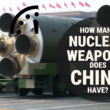In his recent column, “Deterrence, without nuclear winter,” Seth Baum concludes that non-contagious biological weapons are one of two viable alternatives to replacing nuclear weapons in order to achieve what he calls “winter-safe deterrence.” He writes that non-contagious biological weapons “could work well if deterrence required threatening large human populations” without posing the risk of a global catastrophe like nuclear winter or a pandemic. Leaving aside the disturbing normative and legal implications of Baum’s proposal to start a global biological arms race, I will focus on the strategic logic underpinning his proposal to replace nuclear weapons with biological weapons. Baum’s conclusion is based on an uncritical acceptance of the long-standing myth that biological weapons are “the poor man’s atomic bomb.” This myth is based on the simplistic notion that because biological weapons could potentially cause mass casualties on par with those caused by nuclear weapons, these weapons should have similar political effects and implications for international security. Although biological and nuclear weapons are both considered weapons of mass destruction, biological weapons differ from nuclear weapons in three important ways that undermine the utility of biological weapons for deterrence: uncertainty of effects, availability of defenses, and the need for secrecy and surprise.
The first significant difference involves the level of uncertainty associated with the employment of these weapons. Nuclear weapons deliver instantaneous, overwhelming, and predictable levels of destruction. The effects of biological weapons, on the other hand, are delayed, variable, and difficult to predict due to their sensitivity to environmental conditions and the importance of pathogen-host interactions. In addition, the lack of operational experience with these weapons and the inability to simulate realistically their effects (short of massive human experimentation) impedes the ability of states to substantially reduce this level of uncertainty.
The second major difference between nuclear and biological weapons concerns the availability of defenses. There are no effective defenses against the effects of a nuclear attack. There are, however, a number of countermeasures that can be taken before, during, and after a biological attack that can mitigate the consequences of such an attack. Masks and filters can prevent exposure to biological agents. Biological weapons are also unique in that vaccines can be used to protect soldiers and civilians before an actual attack occurs. Because diseases have an incubation period of days to weeks, defenders have a window of opportunity to detect an attack using sensors and biosurveillance systems. Early detection can trigger the distribution of medical countermeasures to treat the victims of an attack and there are already vaccines and /or treatments available for the most lethal diseases such as anthrax, plague, smallpox, and tularemia. As a result, the effects of a biological attack are not absolute and incontestable; they can be mitigated and limited by a well-prepared defender. This possibility is likely to reduce the confidence of states in their ability to reliably inflict unacceptable damage against an adversary in a retaliatory strike. The full panoply of defenses need not be deployed constantly at full readiness because the very availability of these defenses may be sufficient to dissuade a state from calculating that it can inflict unacceptable damage. Although civilian populations will remain more vulnerable to biological weapons than will military forces, damage limitation remains a viable option for larger, more advanced states facing less sophisticated adversaries.
Third, biological weapons have limited value as strategic deterrents due to the need for states to shroud their biological weapons programs in strict secrecy. This need for secrecy is driven by normative, legal, and strategic considerations. In the strategic context, the availability of defenses against biological weapons places a premium on the attacker achieving surprise. This undermines the ability of a state to use biological weapons as a deterrent in two ways. First, the secrecy required to retain the element of surprise in a biological attack reduces a state’s ability to issue credible threats to inflict unacceptable damage against an adversary. To make a deterrent threat credible, a state would not only have to admit that it was violating international norms and laws but it would also have to reveal details about its offensive biological warfare capabilities such as the types of agents it has developed and their means of delivery. These revelations could reduce the effectiveness of these weapons by allowing the defender to mobilize appropriate countermeasures. In contrast, the superpowers flaunted their nuclear forces during the Cold War for deterrent purposes. They were able to do this because these demonstrations of their nuclear capabilities did not provide the other side with an improved means of defending against them. Second, secrecy is a flimsy means of protecting strategic forces designed for deterrence. Strategic forces that depend on secrecy for their protection are vulnerable to intelligence breakthroughs by an adversary. If a defender gained inside information about an attacker’s capabilities, it would be possible to develop and stockpile new pharmaceuticals, immunize the at-risk population, distribute protective masks and treatments, enhance public health surveillance, and take other precautions that could substantially mitigate the impact of a first-strike or retaliatory attack with biological weapons. Although such information is difficult to acquire, the cases of Soviet biologist Vladimir Pasechnik, former Soviet bioweapons program official Ken Alibek, and Iraqi weapons official Hussein Kamal attest to the risk posed by the defection of high-level government officials knowledgeable about their nation’s biological warfare programs.
A careful analysis of the technical and strategic aspects of biological weapons reveals that while biological weapons have the potential to inflict unacceptable damage against an adversary, they are unable to offer states an “assured” capability for doing so. This shortfall significantly undermines the suitability of biological weapons to serve as a strategic deterrent. Whatever the merits may be of pursuing “winter-safe deterrence,” promoting the discredited concept of biological weapons as a “poor man’s atomic bomb” is not an analytically defensible means of achieving that objective.
Share: [addthis tool="addthis_inline_share_toolbox"]














